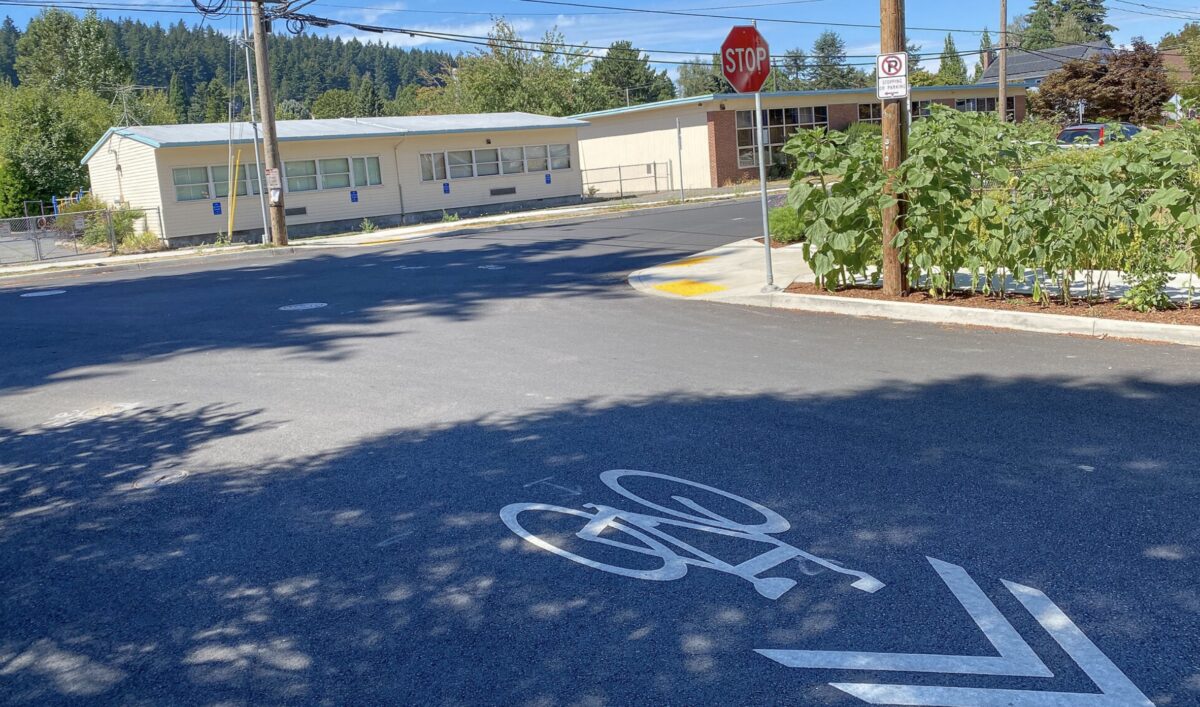
(Photos: Jonathan Maus/BikePortland)
Happy Earth Day Portland!
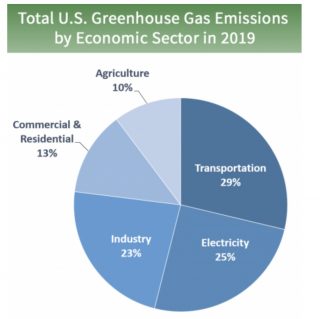
For the first time in a long time, it feels like Americans are ready to take real steps toward a dramatic reduction in greenhouse gas emissions.
Today at his virtual climate summit, President Joe Biden made a commitment to cut U.S. emissions in half by 2030. Transportation is the largest source of greenhouse gases (around 29% of the total emitted as of 2019) and Biden’s Transportation Secretary Pete Buttigieg has sent clear signals that it’s time for the country to set off on a new path when it comes to how we move around.
Closer to home, Portland has been a leader in clean transportation. We pioneered what it means to be a bike-friendly American city and were a model of how to integrate light rail and streetcars into a car-dominated landscape.
But lately we’ve slid back onto our laurels. It’s time to find our bold transportation leadership again.
Advertisement
The good news is our transportation department has already taken some first steps. The bad news is, the steps are too small. Portland has this problem where we make a molehill when we actually need a mountain. We do things just good enough to get a headline or two, but we don’t follow-through with actions that would really move the needle in the timeframe required to meet the moment.
Here are four steps we’ve already taken to re-think streets in a way that would reduce emissions, and my thoughts on how we can follow-through to make real and lasting change…
Expand and improve Safe Streets installations
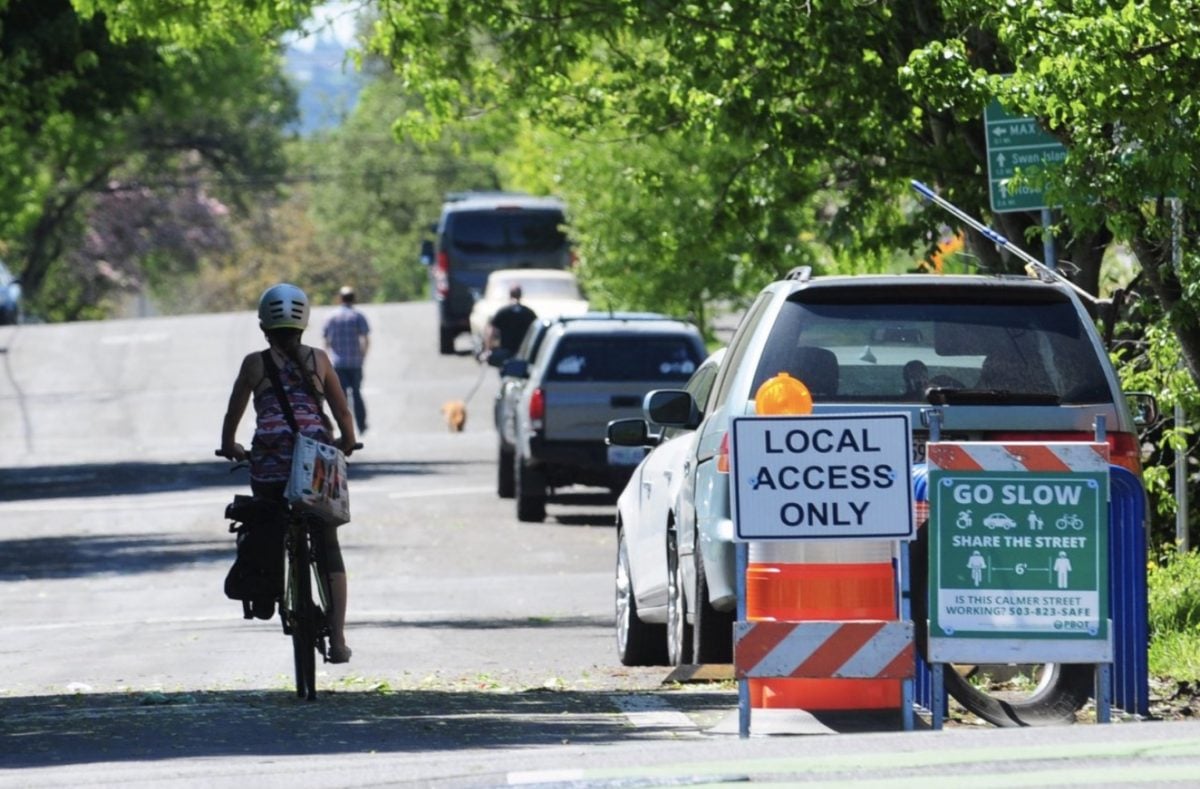
Back when Covid first hit, PBOT responded by installing temporary barricades and signs on residential streets throughout Portland. The idea was to reduce driving and expand opportunity for active transportation like walking, biking, running, and so on. The Safe Streets/Slow Streets installations are almost one year old. It’s time to make them permanent. Let’s seize this space for good so cleaner and healthier mobility choices have room to grow and thrive.
Ban driving adjacent to schools
The health of kids around schools should be sacrosanct, so why do we allow unfettered access to them by the most toxic and dangerous vehicles? Portland is one of the leading “Safe Routes to Schools” cities in America. PBOT does great work in this area; but we must do more. It’s time to take the bull by the horns and prohibit driving near schools.
“School Streets” is a growing movement that is already on the ground in Vancouver, BC and in Seattle. PBOT is familiar with the concept. They’ve created carfree streets outside at least two schools already: on NE Klickitat between 23rd and 24th (Madeleine Catholic School) and on N Delaware between Bryant and Saratoga (Chief Joseph Elementary School).
Both of those examples were opportunistic and were not done as part of a strategic plan. PBOT could seize the moment and find many other schools where certain blocks could be carfree zones in order to improve health and safety of people and the planet.
Improve and expand Healthy Business plazas
PBOT’s Healthy Business permit program has been a success and has helped ease the pain of the pandemic for business owners and customers. Now we should expand the program and make the plazas even better.
Currently many of the plazas stretch across the entire street, leaving no pass-through space for non-drivers or emergency responders. The permits require an 11-foot wide minimum lane at all times. It would also be great to ditch those big, ugly “ROAD CLOSED” barricades at the entry to each plaza. These spaces should welcome people, not make them feel like they’re entering a work zone!
PBOT Commissioner Jo Ann Hardesty wants more carfree zones. It seems to me the success of the business plaza permit program could be relatively easily leveraged toward Hardesty’s vision.
Add protection to existing buffered bike lanes

Portland has dozens of miles of buffered bike lanes. These are the ones where there’s a double-stripe on the outside edge of the lane. This added buffer is nice, but it creates no protection for vulnerable road users. We need to fill these buffers with some type of physical separation. The space is already there, all we need is to add more plastic curbs, delineator wands, concrete walls — whatever it takes to create the reality and perception of safety that is crucial if we want to increase the rate of bicycle use in Portland.
**BONUS IDEA** Reform police traffic enforcement and pretextual stops
The threat of a negative police interaction while using the street is a serious concern for some Portlanders of color.
If we expect Black, Indigenous and people of color to get on a bike, we must make sure they’re not hassled by police for a minor traffic violation. These type of stops are what led to the death of Daunte Wright, Sandra Bland, and countless others. Wright’s killing has led to growing criticism of pretextual traffic stops nationwide.
There are many low-level offenses in the Oregon Revised Statutes that are used as pretextual traffic stops that can be an excuse for an officer to target someone. Laws that govern helmet use, sidewalk riding, crossing the street, equipment requirements (like lights and reflectors), and so on, should be revisited. In Berkeley, city leaders recently voted to ban police from making these type of low-level stops. In Portland, lawyer and advocate Scott Kocher (who published the landmark Fatal Pedestrian Crash Report in March) believes “petty pedestrian offenses should be eliminated… to limit the inequitable effect of enforcement.”
These are just a few examples of ways we can unlock the potential of our streets, change transportation behaviors, and reduce greenhouse gas emissions from transportation.
It’s very simple: When people feel safe to bike and walk, more of them will do it. When people are intimidated by drivers and their cars, fewer of them will.
What are your ideas?
— Jonathan Maus: (503) 706-8804, @jonathan_maus on Twitter and jonathan@bikeportland.org
— Get our headlines delivered to your inbox.
— Support this independent community media outlet with a one-time contribution or monthly subscription.




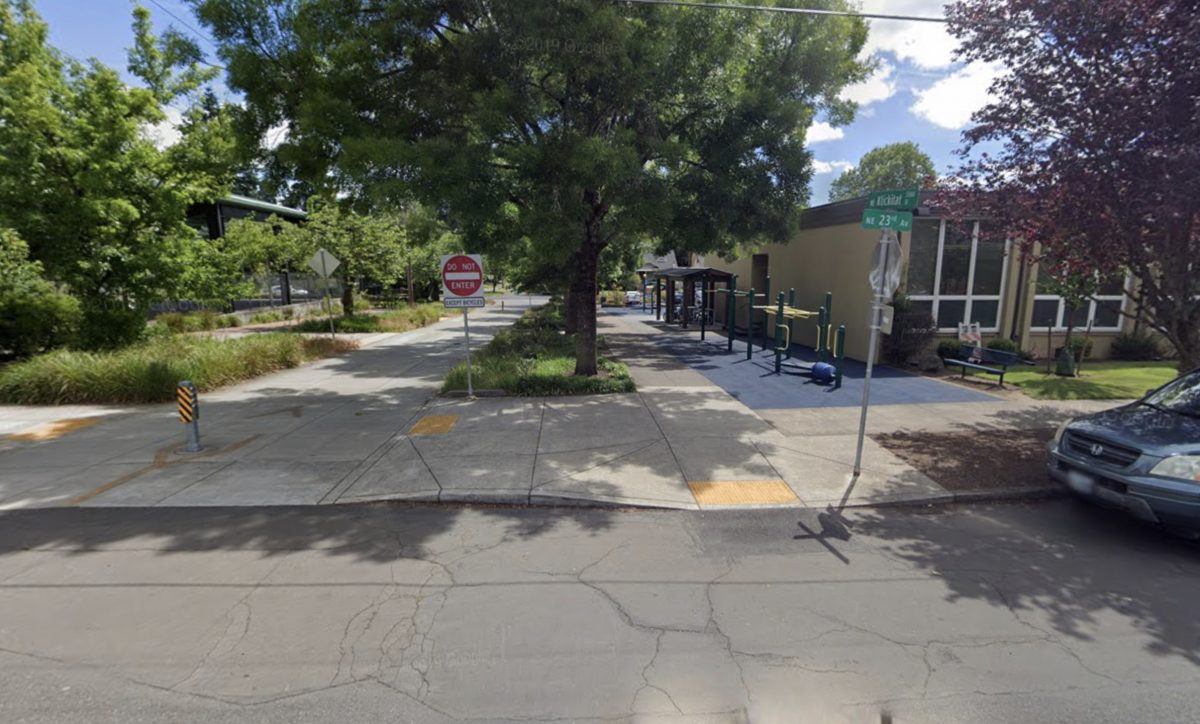
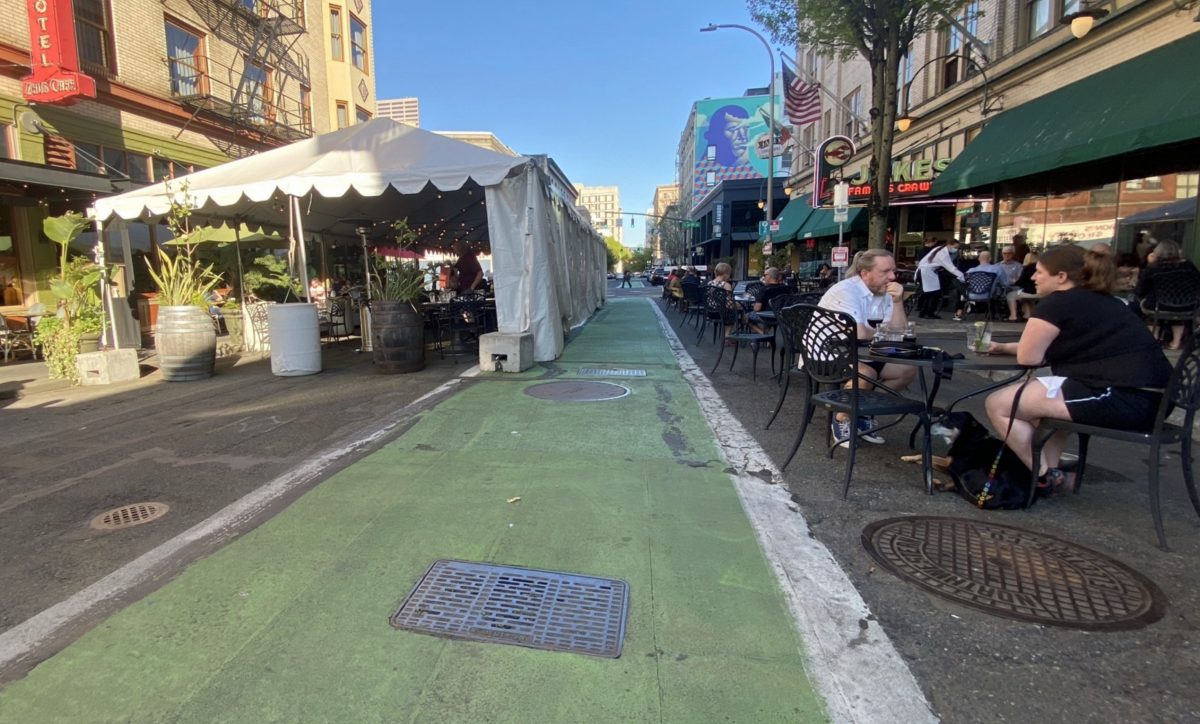
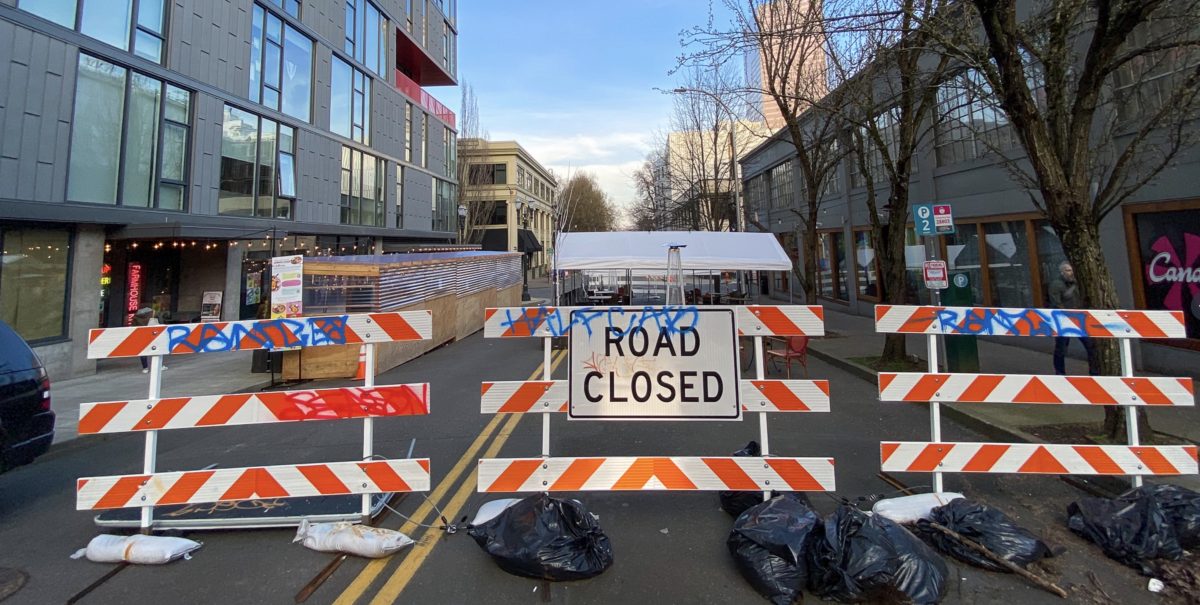
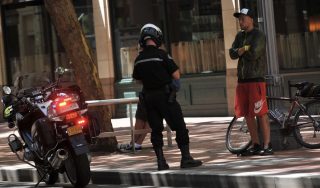
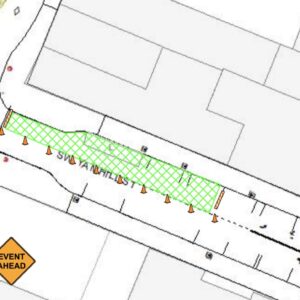


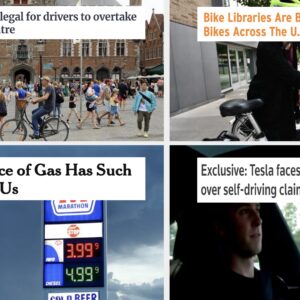
Thanks for reading.
BikePortland has served this community with independent community journalism since 2005. We rely on subscriptions from readers like you to survive. Your financial support is vital in keeping this valuable resource alive and well.
Please subscribe today to strengthen and expand our work.
I have a couple:
When re-striping, stripe driving lanes, not bike lanes. Provide 10-foot or 10.5′ lanes for people driving, and leave the rest of the space for people on bikes. There are not a tone of streets this would impact, but N Interstate is one that would see a lot more space for people on bikes between the Rose Quarter and Kaiser.
Also- FILL IN THE GAPS! Our network of bike infrastructure will not be useful for the 8-80 crowd with all of the dangerous connections and gaps. Fill in the gap and complete the bike lanes between N Michigan and NE 7th/9th. Create a safe connection between Greeley and Interstate and Greeley/Willamette. Connect Vancouver/Williams to something at the south end! Create a direct connection the soon to be opened Blumenaur bridge. So much decent infrastructure for bikes being wasted for lack of connections or dangerous gaps.
Repave streets less often.
Do as Europeans do and use removable pavers and curbs instead of asphalt or concrete.
Reduce traffic and turn lanes to no more than 10 feet including for the lines.
Move power and telephone lines underground.
Replace signals with diverters and roundabouts wherever possible.
Restrict the movement of cars and trucks during the day.
Move all interstate freight to ships and trains, increase weight-mile taxes by 10x.
Never let a bus encounter a stop sign or a red light unless it is a pedestrian-activated signal.
Pedestrian activated signals cause an immediate yellow signal in all lanes entering an intersection.
Poorly paved roads cost cyclists a fortune on wheels, wheel truing, and cracked frames & forks…
Reduce sprawl by cutting off all public utilities to any rural dwelling where the owner (or tenant) is not earning a majority of their income by engaging in agriculture. Restrict fixing roads in rural areas to state highways.
Before or after we have Socialized Medicine and you take my guns? 😉
WTF ???
The residents of most rural homes were never inhabited by people who earned “a majority of their income by engaging in agriculture”. If you were to visit the Nation a hundred years ago, you would learn that most rural farmers had an additional source of income, which usually exceeded their profits from farming. They were also ranchers, blacksmiths, carpenters, sawmill operators, doctors, teachers, ministers, etc., etc.
I think parents are going to display the most pushback to restricting driving around schools to be honest. The N Central “greenway” between N Buchanan and N Ida is a no-go Monday through Friday nine months out of the year with parents in single-occupant vehicles clogging the street.
What we really need though is a change in the C-Suite leadership at PBOT. Stale ideas from people who are retired in place. We make a molehill when we need a mountain because PBOT is an archaic agency more focused on preserving access for motorist and placating NIMBY property owners than creating safe and efficient streets
These ideas are fine, and will allow for incremental improvement. Without a network of separated bike lanes in the inner neighborhoods, there will be no significant change in our modal share. Greenways attract existing riders, but have had no significant measurable effect on modal share for a decade. If we actually want to make a significant change, that’s how we do it.
Yes. Our investment in Interstate highways sent the message that car travel is comfortable, convenient and fast. The economy blossomed in areas close to freeways and car-related development of homes, business and industry became the norm. The huge government subsidy of motor vehicles is largely invisible and forgotten.
Bike infrastructure is much cheaper than car infrastructure and covers much less landscape. Unfortunately many of the places you might want to use to move bikes are covered with cars. Some of these cars will not move for days.
While I agree with the comments above regarding the need for separated bikeways, it’s never felt like the Greenway network was completed. As others have noted, too many gaps exist in the network. I live in North, and was in Outer SE last week, and the network is there, but barely noticeable. I kept having to stop and route by phone. Any measurement of the Greenway’s impact on mode share will be largely immaterial, as it’s measuring a network that is substantially incomplete.
Even what’s exists isn’t good enough to make hesitant people use them. PBOT’s refusal to use anything more than sharrows in most cases means a trip on a “greenway” rarely doesn’t involve getting passed by multiple speeding motorist. I regularly use N. Central, N. Willamette, N. Concord, and N. Rodney and N. Willamette is the only one that isn’t congested with vehicles. N. Central is very sketchy because the fastest route from the St. Johns Bridge to N. Columbia involves driving on the N. Central “greenway”. Cut through drivers frequently speed down the street or run stop signs.
It’s not that our greenways failed, it’s that we don’t really have greenways at all.
comment of the week!
Part of the solution should involve creating neighborhood “labyrinths” that force drivers into circuitous, inefficient routes that discourage cut-thru driving. Thru traffic should use arterials while side streets are for residents and active transportation. You can still drive to your house, but impatient commuters can’t fly through unimpeded. Stop signs don’t help, only barriers.
YES jonno! You’re talking about permeability, the extent to which streets allow, or do not allow, through traffic. I would argue that all neighborhoods should have this to such an extent as to make inner city residential neighborhoods feel like cul-de-sacs. This is likely what has made neighborhood greenways a victim of their own “success.” They attract existing riders, and when PBoT adjusts stop signs to allow through traffic, they attract even more cars. This empties any standard bike lanes in the area (because they’re stressful and unsafe), and fills residential streets with people on bikes and cut-through traffic.
Alain agreed. First, yes this is only one paper, and I hope it spurs on more research on greenways, particularly the difference between residential streets with frequent diverters vs others. Second, I live in (and come from) E Portland and I still have to check my phone regularly when I zig zag through residential neighborhoods to get to a safer street. Right now, Portland is one of the only cities I know of where this debate is happening: greenways are “good enough.” Almost every candidate for NYC Mayor talks about open streets and PBLs, and likely has no clue about neighborhood boulevards. My hope is that the debate in Portland moves away from either/or to “A separated and safe network is absolutely necessary to make any significant impact on climate change, and auxiliary residential streets can help with this.”
Yes, indeed, make more and make better. Fill the gaps, create better infrastructure (diverters, barriers, etc), and more separation. Interestingly, the streets where I feel ‘safest’, if I can even use that word (since it’s not entirely accurate to say I feel safe riding most anywhere in Portland) are streets with higher density, and/or mix of commercial and residential. NE Multnomah is on the top of my list. Almost never had a conflict on this street (traffic volumes are typically very low, comparatively). N Williams is relatively nice, but definitely has some terrible spots, and I might add N Rosa Parks in there, at least large sections of it. Two of these are mostly protected, and N Williams is decent because in sections (say, Fremont to Skidmore) traffic is somewhat calmed. But in using these streets, I am a poor measure of success, since I feel relatively confident as a rider. That leaves out a whole lot of folks!
I love all of these ideas but would make one change to the proposed changes to traffic stops: to ensure the safety and comfort of people who are walking and rolling, the city should continue to enforce the ban on sidewalk riding. We’re all pedestrians and we need allies. Let’s make sure that when others think of a cyclist, their most vivid image isn’t of nearly being hit by an inconsiderate cyclist flouting the law and putting them at risk.
Hi Mark in NoPo,
I disagree about the sidewalk riding thing. I think it reeks of paternalism and double standards to ban sidewalk riding while we allow driving in dense areas. IMO the correct policy response to these concerns are to 1) give bicycle riders/rollers safe space in the street and 2) require bicycle riders/rollers to use extreme caution and slow to a walking pace when others are present. We need policy that encourages safe behaviors, not policy that criminalizes/punishes people for doing a natural thing that the built environment encourages.
What ban on sidewalk riding?
From the statute, the ban is only:
So, only downtown, and even there not including bridge ramps or the south park blocks.
That’s not an outright ban, is it? Think it basically just says people walking have the right of way on the sidewalk. And people on bikes are accountable to ride safely and courteously.
Sorry, squareman, I was referring to, you know, the entire rest of the city. Didn’t know we were restricting the conversation to just one relatively small area downtown.
And thanks for condescendingly overexplaining while (somewhat ironically) calling me cranky. Oh well, I guess it’ll be another several months before I once again begin to forget why I generally stay out of this comments section. (short answer: snippy knowitallism just gets me down).
Later, crocodiles.
I’m well aware of the ban in a portion of downtown. I thought it pretty obvious the OP wasn’t referring to such a trivial and largely irrelevant ban, as surely enforcing that isn’t going to accomplish the objective Mark in NoPo is hoping for.
Other than in downtown Portland (and other core urban areas in Oregon, which I guess means…Eugene and Salem?) bicycles can lawfully ride on all sidewalks. Of course, they must yield to pedestrians and not otherwise create safety hazards. But riding on the sidewalk, outside downtown, is not prohibited by state or local law.
One more: ensure that pedestrians and drivers can see one another by enforcing the ban on parking near the corner of an intersection.
Instead of banning the practice on paper, it would be more effective if the city erected bollards at intersections or installed bike + scooter parking near the intersection.
Yes, Hoboken has done this with some success.
They’ve started doing this in my neighborhood – the problem is they don’t go nearly far enough, and there’s almost always some van or other huge SUV parked right against the bollards, completely blocking all visibility anyway.
They’d either need to get a lot more aggressive and remove more parking or impose a height limit to the edge spots (not sure that’s been done anywhere, but I don’t see how hard it would be to have a sign that says “You must be this short to park in this spot”) – either of which I’d support.
My favorite, the zig zag going south/north from NE Rodney to NE Hancock to NE 3rd to cross NE Broadway. There is nearly always cars parked right up to the corner on NE Hancock, and almost always fast moving traffic on NE Hancock that is difficult to see, including employees from the Toyota dealership who like to speed down Hancock. I absolutely hate making this connection, and yet it’s a side street, should be real easy.
Plant trees on freeway embankments, shoulders and medians.
LOL yes please.
Plant trees in the middle of the lanes on all roads and streets.
It seems the (more) permanent Safe Streets are already underway? PBOT was at the last St Johns NA meeting discussing their plans to replace the barriers on N Central with concrete planters. I think they’ve already marked locations on the street. Sounded like they’re doing the same elsewhere. Unfortunately we may lose one of the current barriers (at St Louis/Fessenden) but the remaining would be improved.
Just some basic zoning reform could have a big impact. Make one of the primary goals for zoning to achieve a walk score as high as possible. Currently most zoning laws are purposely and intentionally designed to keep desired destinations as separated and as far apart as possible. Its setup in the worst case scenario, so ripe for improvement. Even small changes could help, like requiring walk score assessment and mitigation as an independent variable in environmental impact assessments.
Absolutely reform traffic enforcement! I’d add ending street harassment as well. Both of those aren’t really cheap or easy, but necessary if people are going to feel safe enough in public spaces to bike, take transit, or walk.
An actual cheap and easy suggestion is more bike parking, especially if it’s covered.
Hey Emily, I have no real evidence on this, but it’s possible the same people who harass others, act with disregard to the safety of others and are generally awful at driving, are also likely those people who speed regularly. So speed cameras may not specifically focus on people who harass others, but will likely have some effect on them if we install cameras widely enough.
Establish citywide permit parking. Permit costs would be a sliding scale based on income; free to anyone at or below 400% of the federal poverty level and increasingly expensive as income rises. Two-hour visitor parking, as exists currently in permitted spaces, would continue. Ban any new multidwelling developments from having any off-street parking except areas for loading/unloading and emergency access.
Ban any street parking within 10 feet of a street corner or crosswalk (i.e. not counting driveways) to improve sightlines for walkers, rollers and drivers. Eliminate uncontrolled intersections by, at the very least, placing yield signs on at least one axis of the intersection.
With the money raised from the parking permits, the first priority would be making public transit free for all users. Passenger revenue on TriMet is just 5.7% of their overall budget! (Source, PDF, page 34.) Free public transit is has been adopted by other cities and, in addition to losing a very small percentage of revenue, would simultaneously reduce costs in fare collection/maintenance and fare enforcement.
Second priority would be finishing and connecting the biking (and walking!) networks, and better allowing for/encouraging multimodal transit. This would include expanding bike lockers and ebike/scooter docking/storage areas at Max and major bus stops, as well as exploring bus-bike trailers, or at least getting 3-bike racks.
Third priority would be all of the other great ideas on this thread 🙂
My suggestion is, in addition to expanding Healthy Business plazas, creating genuine public pop-up plazas with cheap tables and chairs—or maybe even natural/quasi-natural sitting materials like rocks and astroturf. Even better if they’re implemented where main streets intersect with greenways, giving people a place to chill and acting as giant diverters.
All of us can advocate and act!
Talk to your neighbors and be heard when it comes to using active transportation! Share with them that collectively, we as Portlanders have to make better habits and actually value the transition to sustainable living over our complacency and convenience.
We often spend so much time in our active transpo/biking bubbles debating the nuances of infrastructure and politics. however, infrastructure is simply a response to our habits and politics a response to our values.
Take a step back:
Tell people what it’ll take to live sustainably, and why we should value it. Reach out to neighbors and advocate for their options other than driving. Acknowledge that the hard pill to swallow is: yes. Its generally more convenient to drive if we have the privilege to do so. But if we can, we have to surrender that privilege knowing its impact to the climate and the urgency our world now demands of us.
There are many good ideas here, including repealing laws for petty non-motorized offenses. But I want stricter enforcement of laws around the operation of motor vehicles. Or said another way, I want increased accountability for owners and operators of motor vehicles. I’d like to see zero tolerance for driving unregistered, uninsured and unsafe vehicles and zero tolerance for urban speeding. Whether this needs to be enforced subjectively by armed humans is another matter, but creating safer streets requires that we elevate the seriousness of driving and the consequences for driving outside the bounds of traffic law.
Having worked as a mechanic I have to point out that there are few truly “unsafe” motor vehicles on the road. The folks without insurance are often without a license due to a DUI, however. As for unregistered, I have done that myself as I had to find a DEQ station that would treat a half-breed like myself like anyone else instead of making me come back four or more times to pass over a reading that is within 99.9% of the requirement…
Aas for urban speeding, I personally have pissed off countless other drivers by obeying the posted speed limit & basic speed rule, because I drive 25 mph or less in neighborhoods and near public parks…
Instead of the city of Portland attempting to force people to go “car-less” by only having a few parking spaces for large apartment buildings, they should require a parking space per unit with a 220V AC outlet for electric cars. Most people who attempt to go “car-less” end up buying a car within a few years when they find out that the car share programs suck…
When people come up with ideas that are worse for the environment than the issues we currently have.
Earth to Mars. If you limit car travel to a select few streets, it will cause more traffic. A vehicle taking 35 minutes to travel in traffic a specific distance will emit more greenhouse gasses than a car traveling the same distance without traffic in 25 minutes.
Though, some people do not understand basic physics and logic, forcing people to participate in regulation through frustration will ultimately backfire.
Ignorance is bliss while you have wind in your hair.
Assumption: Less streets designed for car travel will result in the same
(not fewer) amount of people using cars. This is the traditional assumption many DOTs have used for a century to expand freeways/highways. After expansion and within a short amount of time, those highways fill with cars.
Let’s look at this assumption from a different point of view: “If you limit [bicycle and train] travel to a select few streets, it will cause more traffic.” At present our streets are designed primarily for the fast movement of cars, leaving us with really only one option for travel. Should we give people an option or continue require that they purchase and use cars?
If you simply can’t drive through a street, is that road truly closed? That’s not the sign they put up to say you can’t walk on the freeway.
Seems like sweeping the bikes lanes might be cheap & effective.
I’d like a little bike lane sweeping, but I can also just go buy some tuf-tires(TM) They cost about $90 for a set but it’s a timesaver compared to calling 503-823-1700 and talking to the dispatcher. For another $30 your LBS will mount them and tell you your brake pads are toast.
Give employers incentives for telework! In April 2020, when I ran an errand on nearly empty streets, it became very clear to me that we don’t have to spend billions of dollars widening I-5 and other traffic infrastructure, we could just give employers a fraction of that money to keep their employees at home.
I work in HR and feel very lucky that my employer has embraced 100% telework (including post-covid) but I know so many other employers that refuse, even though more than 70% of their workforce could telework. We need pressure from multiple sources to make this cultural change happen, telework is a big part of reducing vehicle traffic, emissions and wasteful parking garages.
Ban all cars, trucks, busses, cows, and people! We cats would appreciate it!